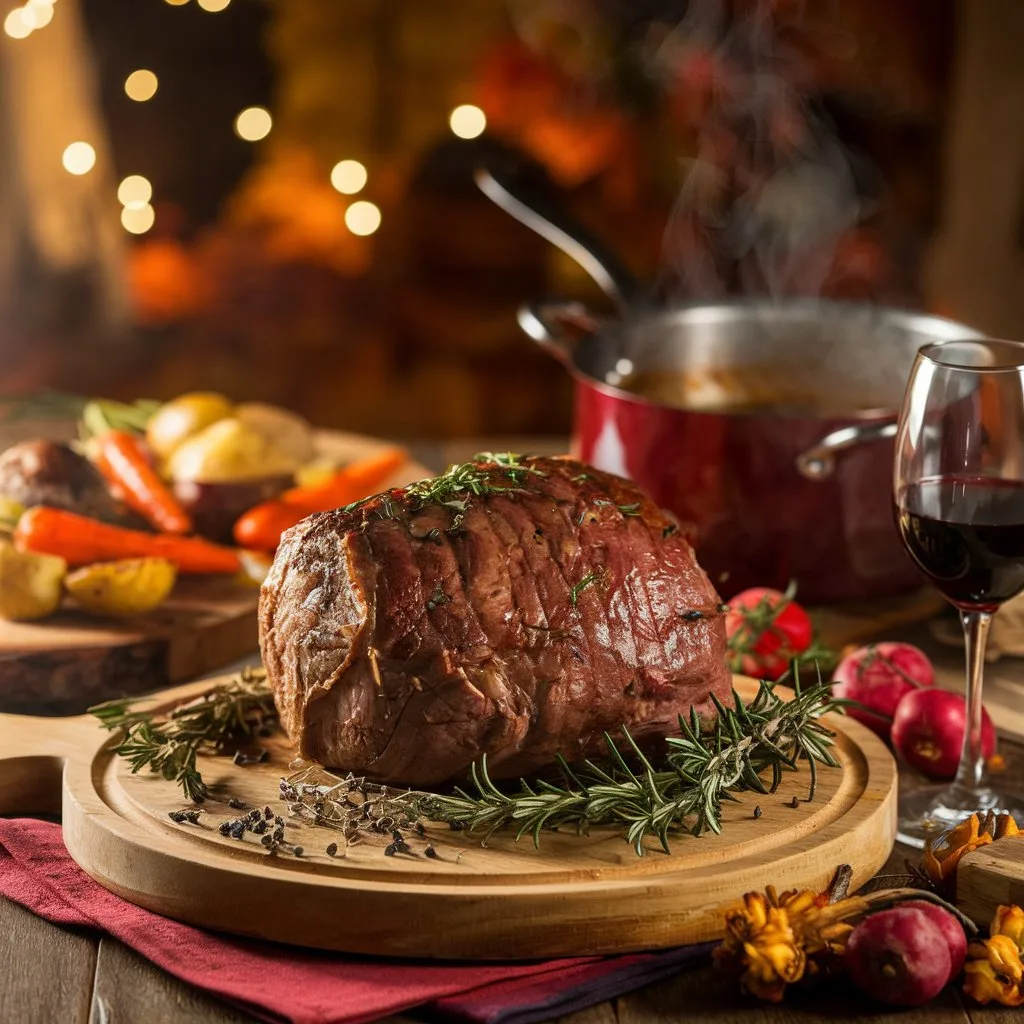As autumn arrives, the smell of a tender deer roast fills the air. I remember my grandmother’s kitchen, filled with the scent of venison. It brought back memories of family and home.
Now, I want to share a recipe that brings out deer meat’s rich flavor and tenderness. It’s perfect for creating a dish that will delight and nourish you.
If you love wild game or are new to venison, this Deer Roast recipe is for you. We’ll cover everything from choosing the right cut to cooking techniques. You’ll learn how to make a deer roast that will impress everyone.
Get ready to make a dish that celebrates nature and the joy of sharing meals with loved ones.
Understanding Deer Meat: Nutrition and Flavor
Venison, the meat from deer, is known for its unique flavor. It’s also packed with nutrients, making it a favorite among those who care about their health. Learning about venison can help you improve your cooking skills with game meat.
The Unique Taste of Venison
Deer meat has a rich, robust flavor that’s slightly gamey. This taste comes from the deer’s diet of leafy greens and berries. Its leanness lets the deer’s natural flavor stand out.
Nutritional Benefits of Deer Meat
- Deer meat is a great source of lean protein, with 26 grams in a 3-ounce serving.
- It’s also rich in iron, with 3.7 milligrams per serving, or 21% of what you need daily.
- With only 4 grams of fat per serving, it’s good for your heart. It’s a smart choice for game meat cooking.
Exploring venison’s flavors and nutrients opens up new cooking possibilities. Knowing about venison’s unique qualities can spark your creativity. It will make every bite a delight for your taste buds.
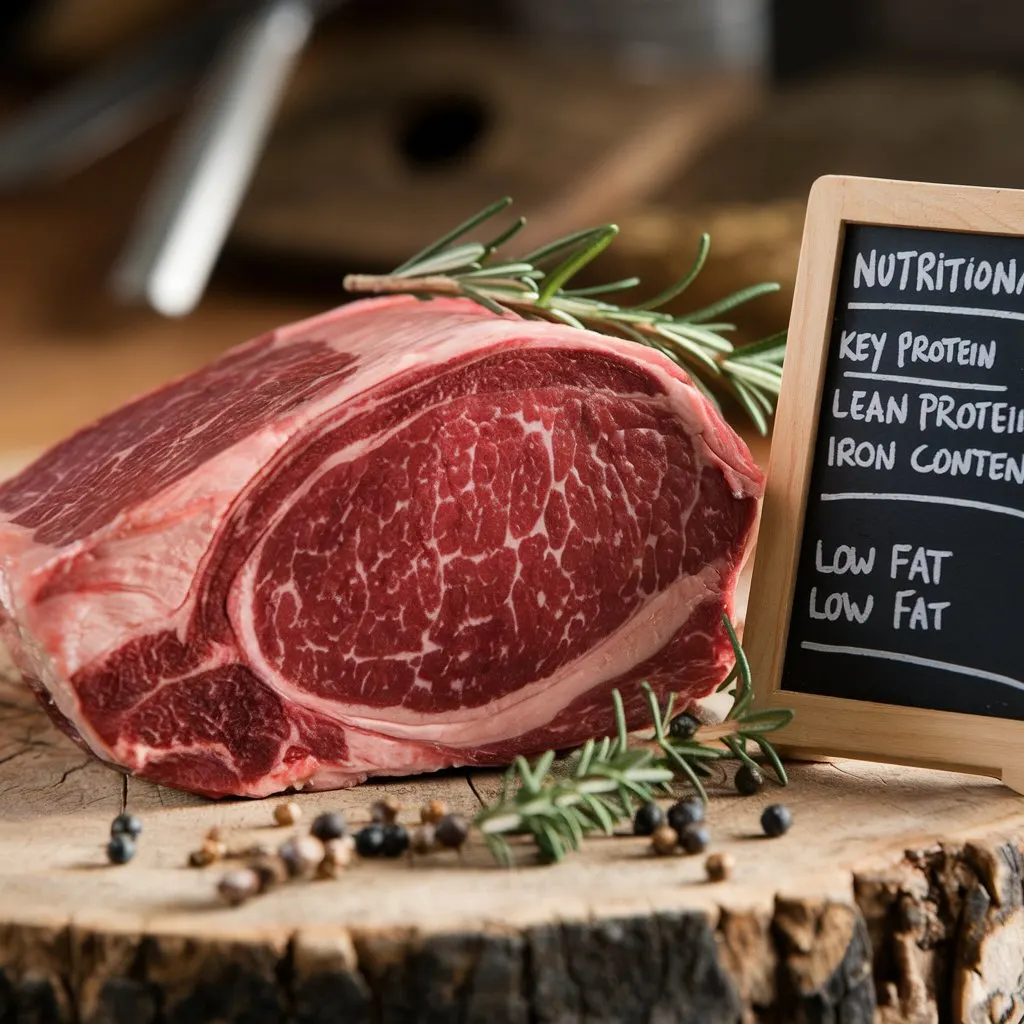
Selecting the Right Cut of Deer
Choosing the right cut of deer meat is key to a tasty venison roast. Learn about the best cuts for roasting and how to pick top-quality venison.
Common Cuts for Roasting
The loin, rump, and shoulder are top choices for venison roast. The loin is tender and lean, perfect for roasting. The rump offers great flavor and versatility. The shoulder works well for slow cooking, becoming tender and juicy.
What to Look for When Choosing Deer Meat
- Color: Venison should have a deep, rich red hue, indicating freshness and high-quality meat.
- Texture: The meat should be firm to the touch, with a fine-grained and smooth texture.
- Marbling: Look for evenly distributed fat marbling throughout the cut, which will contribute to a moist and flavorful roast.
By picking the right cut and checking for these key traits, you’ll make a tender and tasty venison roast. Your family and friends will love it.
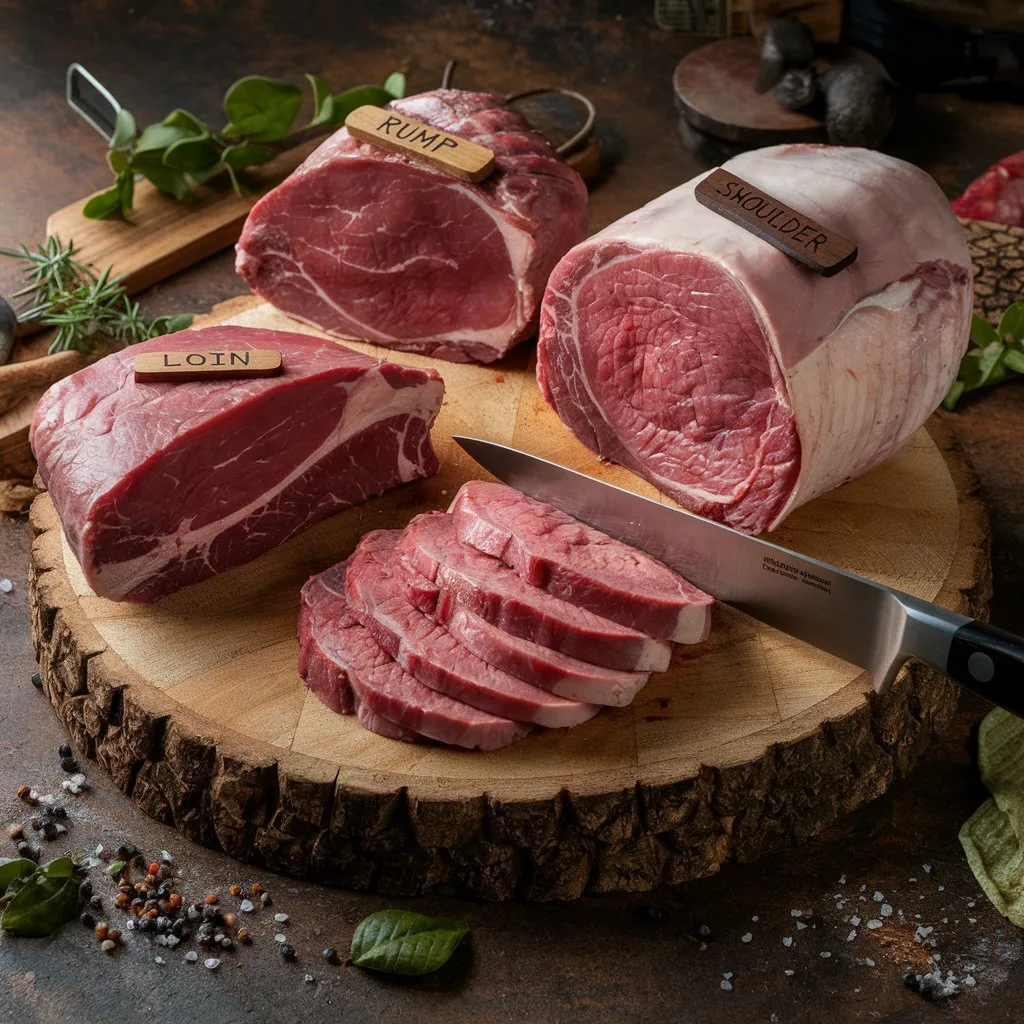
| Cut | Best for Roasting | Flavor Profile |
|---|---|---|
| Loin | Yes | Lean and tender |
| Rump | Yes | Flavorful and versatile |
| Shoulder | Yes | Tender with slow cooking |
Preparing Your Deer Roast: Essential Ingredients
Creating a delicious deer roast starts with the right marinade and seasonings. Marinades make the meat tender. Herbs and spices bring out the game roast‘s natural taste. As you work on your wild game roasting dish, remember these key ingredients to take it to the next level.
Marinades for Tender Meat
A great marinade turns tough deer meat into a tender, juicy roast. Here are some top marinade choices:
- Red wine and herb marinade: Mix red wine, olive oil, garlic, rosemary, and thyme for a classic taste.
- Citrus and soy marinade: Blend orange and lemon juice, soy sauce, and Worcestershire sauce for a tangy, tenderizing mix.
- Yogurt-based marinade: Combine Greek yogurt, lemon juice, garlic, and your favorite herbs and spices for a creamy, flavorful option.
Key Seasonings and Herbs
Enhance your deer roast with a mix of seasonings and herbs. Key ingredients include:
- Rosemary: Its earthy, pine-like flavor complements venison’s rich taste.
- Thyme: This fragrant herb adds a subtle, woodsy note.
- Juniper berries: Cracked juniper berries give a unique, gin-like flavor that suits game meat.
- Black pepper: Freshly cracked black pepper adds a warm, peppery kick.
- Garlic: Minced or roasted garlic boosts the savory aspects of the roast.
Try out these marinades and seasonings to make a deer roast that’s both tender and full of flavor.
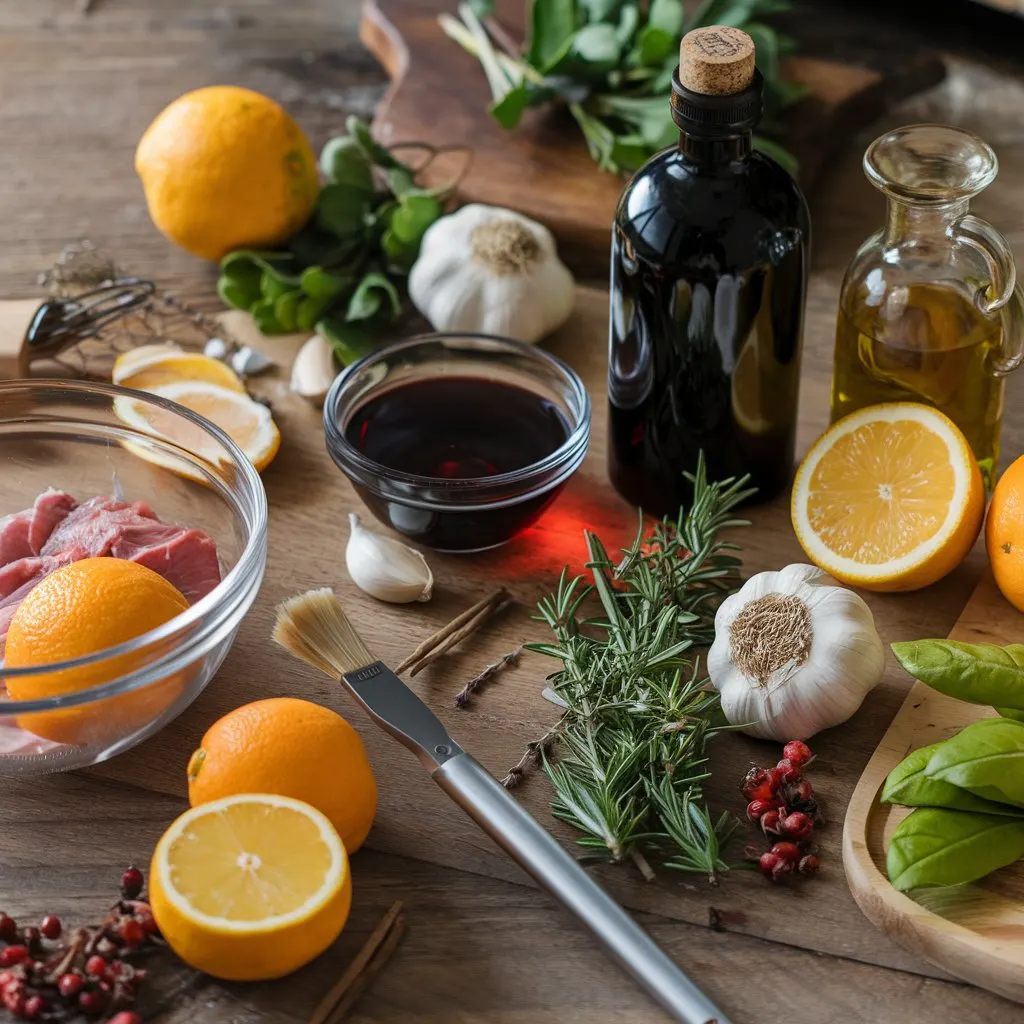
Essential Tools for Cooking Deer Roast
Preparing a delicious deer roast needs more than just the right ingredients. You also need the right kitchen tools and cookware. This ensures your dish is both tasty and tender. Let’s look at the essential tools for cooking deer roast like a pro.
Must-Have Kitchen Equipment
For deer roast, the right equipment is crucial. You’ll need a sharp carving knife, a meat thermometer, and a heavy-duty basting brush. A meat tenderizer helps break down venison’s tough fibers. Also, a good set of kitchen shears is useful for trimming fat and sinew.
Recommended Cookware for Roasting
Choose a large, oven-safe roasting pan or Dutch oven for the best results. Cast iron is great because it heats evenly and keeps heat well, perfect for cast iron roasting. You can also try outdoor cooking with a cast iron Dutch oven over a campfire or grill for a unique taste.
If you don’t have a roasting pan, a rimmed baking sheet lined with foil or parchment paper works too. Make sure the pan or sheet is big enough for the whole roast without overcrowding.
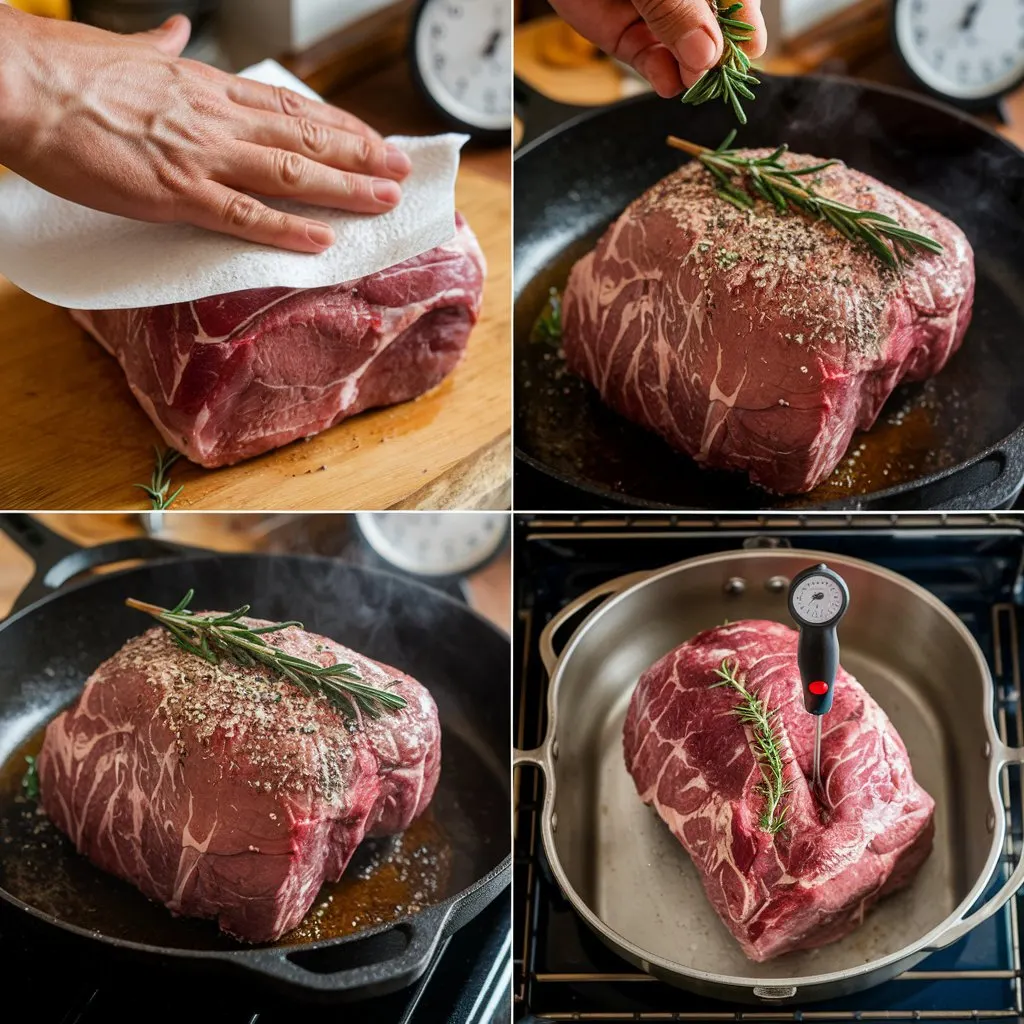
“The right tools can transform a good deer roast into a culinary masterpiece.”
Having the right equipment is key to cooking a great deer roast. With the essentials, you’ll make a tender, flavorful dish that will wow your guests.
Step-By-Step Guide to Cooking Deer Roast
Preparing a delicious deer roast is easy with a few steps. It makes the meat tender and full of flavor. This guide is perfect for both seasoned and new cooks of deer roast.
Prepping the Meat
Start by drying the deer roast with paper towels. This step helps the meat sear and brown well. Then, season it with your favorite game meat cooking spices and herbs like garlic, rosemary, and black pepper.
Roasting Techniques Explained
There are a few ways to roast a deer roast. You can use the oven, searing the meat first in a hot skillet. Or, slow-cook it in a crock pot or Dutch oven for tender meat.
Checking for Doneness
It’s important to check the deer roast recipe for doneness. Use a meat thermometer to see if it’s 145°F for medium-rare or 160°F for medium. Let it rest for 10-15 minutes before slicing to keep the juices in.

By following these steps, you’ll make a delicious deer roast that everyone will love. Enjoy the special flavor of this game meat with confidence.
Side Dishes That Complement Deer Roast
When you serve a flavorful deer roast, it’s key to pair it with side dishes that enhance its taste. You can choose from seasonal veggies to hearty starches. These options make a complete and satisfying meal, whether it’s during hunting season or an outdoor cooking trip.
Popular Vegetable Pairings
Vegetables offer a nice contrast to the richness of deer roast. Roasting root veggies like carrots, potatoes, and parsnips brings out their earthy flavors. For a bright note, try sautéed greens like kale, spinach, or Brussels sprouts. Grilled or roasted asparagus, zucchini, and bell peppers also pair well.
Perfect Starches to Serve
- Creamy mashed potatoes
- Buttery garlic roasted potatoes
- Fluffy wild rice pilaf
- Savory herbed stuffing or dressing
- Buttered egg noodles or pasta
| Side Dish | Flavor Profile | Preparation Time |
|---|---|---|
| Roasted Root Vegetables | Earthy, caramelized | 45-60 minutes |
| Sautéed Kale with Garlic | Bright, slightly bitter | 15-20 minutes |
| Garlic Mashed Potatoes | Creamy, savory | 30-40 minutes |
By mixing different side dishes, you can make a meal that’s both harmonious and fulfilling. It will highlight the best of your deer roast, whether it’s during hunting season or your next outdoor cooking event.
Making a Flavorful Gravy from Your Roast
Make your deer roast even better by making a rich, velvety gravy. Use the natural drippings from your meat. This simple step can make your dish amazing, bringing out the special flavors of game meat cooking and deer roast recipe.
Steps to Create the Perfect Gravy
- Collect the flavorful pan drippings from your roasted deer meat.
- In a saucepan, whisk together the drippings with flour to create a roux, cooking until golden brown.
- Gradually add in beef or venison broth, stirring continuously to prevent lumps.
- Season the gravy with salt, pepper, and any desired herbs or spices, such as thyme or garlic powder.
- Simmer the gravy until it reaches your desired thickness, adjusting the consistency as needed.
Alternative Sauces for Extra Flavor
While a classic gravy is loved by many, you can also try different sauces. A rich mushroom sauce, a tart cranberry compote, or a zesty citrus-based sauce can add a special touch to your venison dish.
| Sauce | Ingredients | Flavor Profile |
|---|---|---|
| Mushroom Sauce | Sautéed mushrooms, beef or venison broth, heavy cream, thyme | Earthy, Creamy |
| Cranberry Compote | Fresh cranberries, sugar, orange zest, cinnamon | Tart, Sweet, Spiced |
| Citrus Sauce | Orange juice, lemon juice, garlic, dijon mustard, honey | Bright, Tangy, Balanced |
Try these alternative sauces to find the perfect match for your game meat cooking. It will take your deer roast to new heights in the kitchen.
Storage Tips for Leftover Deer Roast
Preparing a delicious deer roast is great, but storing leftovers is just as key. Whether you hunt or just love venison, knowing how to keep deer meat fresh is important. Let’s look at how to store and reuse your leftover deer roast.
How to Properly Refrigerate
To keep your leftover deer roast fresh and safe, proper refrigeration is essential. Here are some tips:
- Cut the roast into smaller pieces before refrigerating. This helps it cool down faster and more evenly.
- Put the deer meat in airtight containers or wrap it tightly in plastic or foil. This stops it from drying out or picking up odors.
- Refrigerate the leftover deer roast within 2 hours of cooking. The quicker it cools, the better.
- Eat the refrigerated deer meat within 3-4 days for the best taste and safety.
Creative Ways to Use Leftovers
Don’t waste those deer meat leftovers! There are many tasty ways to use them in new dishes. Here are some ideas for your next deer meat preparation or hunting season recipe:
- Shredded Deer Roast Tacos or Burritos: Use the leftover roast as the main protein in tacos, burritos, or quesadillas.
- Deer Roast Hash: Dice the meat and cook it with potatoes, onions, and peppers for a filling breakfast hash.
- Deer Roast Shepherd’s Pie: Mix shredded venison with veggies and mashed potatoes for a cozy, one-pot meal.
- Deer Roast Soup or Stew: Add cubed leftover meat to a tasty broth with your favorite veggies and spices.
By storing and using your deer roast leftovers wisely, you can enjoy venison’s flavor for longer. Get creative and enjoy the versatility of this meat during the hunting season.
Cooking Deer Roast in Different Ovens
Preparing a delicious deer roast can vary based on the oven type. Whether using a conventional or convection oven, knowing the differences is key. This knowledge helps you achieve perfect results every time.
Adjusting Temperature for Conventional Ovens
In a traditional oven, the secret to great wild game roasting is in the temperature. Start by preheating to 425°F to 450°F. This high heat sears the outside, keeping flavors locked in. After browning, lower the heat to 325°F to 350°F. This lets the inside cook evenly and gently.
Tips for Cooking in a Convection Oven
- Convection ovens cook faster and more evenly. Reduce the temperature by 25°F to 50°F compared to a conventional oven.
- Watch the cooking time closely. Deer roast may cook 30% faster in a convection oven. Adjust the time based on internal temperature.
- For a crispy exterior, sear the roast in a hot skillet before cooking in the convection oven. This adds to the camp cooking experience.
Understanding how to cook deer roast in different ovens ensures tender and flavorful results. These results will impress your loved ones.
Frequently Asked Questions About Deer Roast
Preparing a delicious deer roast can raise some questions. Let’s tackle a few common ones to help you get the best results.
How to Avoid Tough Meat?
To prevent tough deer meat, start with the right cut. Choose the loin or shoulder for the best taste. Avoid the hindquarters as they are tougher.
Marinating the meat before cooking can make it tender. Also, watch your cooking time and temperature. Overcooking can make the meat dry and tough.
Can I Cook Deer Roast Frozen?
Yes, you can cook a deer roast straight from the freezer. But, you need to adjust cooking time and temperature. Increase cooking time by about 50% for a frozen roast.
Thawing the roast in the fridge overnight can help. It ensures even heating and a better result.

